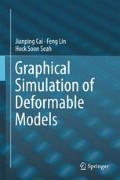Abstract
In this chapter, we investigate transversely isotropic materials for the simulation of deformable objects with fibrous structures. In previous work, direction-dependent behaviors of transversely isotropic materials can only be achieved with an additional energy function which incorporates the material preferred direction. Such an additional energy term increases the computational complexity. We introduce a fiber-field incorporated corotational finite element model (CLFEM) that works directly with a constitutive model of transversely isotropic material. A smooth fiber-field is used to establish the local frames for each element. The orientation information of each element is incorporated into the CLFEM model by adding local transformations onto each element of the stiffness matrix.
Access this chapter
Tax calculation will be finalised at checkout
Purchases are for personal use only
References
Ogden, R. (2003) Nonlinear elasticity, anisotropy, material stability and residual stresses in soft tissue (pp. 65–108). Courses And Lectures-International Centre For Mechanical Sciences.
Picinbono, G., Delingette, H., & Ayache, N. (2001) Nonlinear and anisotropic elastic soft tissue models for medical simulation. IEEE.
Picinbono, G., Delingette, H., & Ayache, N. (2003). Non-linear anisotropic elasticity for real-time surgery simulation. Graphical Models, 65(5), 305–321.
Irving, G., Teran, J., & Fedkiw, R. (2004) Invertible finite elements for robust simulation of large deformation. In Proceedings of the 2004 ACM SIGGRAPH/Eurographics Symposium on Computer Animation (pp. 131–140). Grenoble, France: Eurographics Association.
Teran, J., et al. (2003) Finite volume methods for the simulation of skeletal muscle. In Proceedings of the 2003 ACM SIGGRAPH/Eurographics Symposium on Computer Animation (pp. 68–74). San Diego, California: Eurographics Association.
Liu, N., et al. (2012) Physical material editing with structure embedding for animated solid. In Proceedings of Graphics Interface 2012 (pp. 193–200). Toronto, Ontario, Canada: Canadian Information Processing Society.
Ting, T. C. T. (1996). Anisotropic elasticity: Theory and applications (Vol. 45). USA: Oxford University Press.
Müller, M., & Gross, M. (2004) Interactive virtual materials, In Proceedings of Graphics Interface (pp. 239–246). London, Ontario, Canada: Canadian Human-Computer Communications Society.
Baraff, D., & Witkin, A. (1998) Large steps in cloth simulation. In Proceedings of the 25th annual conference on Computer graphics and interactive techniques (pp. 43–54). ACM.
Takayama, K., et al. (2008). A sketch-based interface for modeling myocardial fiber orientation that considers the layered structure of the ventricles. The Journal of Physiological Sciences: JPS, 58(7), 487–492.
Ijiri, T., et al. (2012). A kinematic approach for efficient and robust simulation of the cardiac beating motion. PLoS ONE, 7(5), e36706.
Rohmer, D., Sitek, A., & Gullberg, G. T. (2007). Reconstruction and visualization of fiber and laminar structure in the normal human heart from ex vivo diffusion tensor magnetic resonance imaging (DTMRI) data. Investigative Radiology, 42(11), 777.
Sosnovik, D. E., et al. (2009). Diffusion MR tractography of the heart. Journal of Cardiovascular Magnetic Resonance, 11(1), 1–15.
Author information
Authors and Affiliations
Corresponding author
Rights and permissions
Copyright information
© 2016 Springer International Publishing Switzerland
About this chapter
Cite this chapter
Cai, J., Lin, F., Seah, H.S. (2016). Fiber Controls in FEM Model for Transversely Isotropic Materials. In: Graphical Simulation of Deformable Models. Springer, Cham. https://doi.org/10.1007/978-3-319-51031-6_4
Download citation
DOI: https://doi.org/10.1007/978-3-319-51031-6_4
Published:
Publisher Name: Springer, Cham
Print ISBN: 978-3-319-51030-9
Online ISBN: 978-3-319-51031-6
eBook Packages: Computer ScienceComputer Science (R0)

